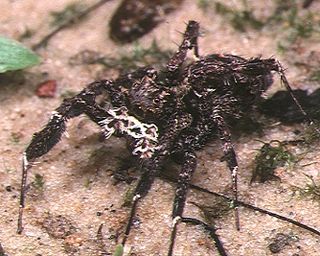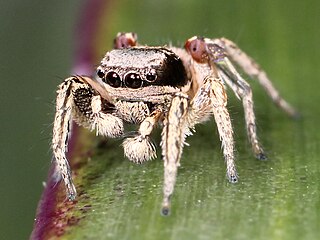Poecilorchestes is a genus of jumping spiders that was first described by Eugène Louis Simon in 1901. As of August 2019 it contains only two species, found only in Papua New Guinea and on Borneo: P. decoratus and P. logunovi.
Proszynskiana is a genus of Asian jumping spiders that was first described by D. V. Logunov in 1996. It is named in honor of arachnologist Jerzy Prószyński.
Thianitara is a genus of Southeast Asian jumping spiders that was first described by Eugène Louis Simon in 1903. As of August 2019 it contains only two species, found in Thailand, Indonesia, and Malaysia: T. spectrum and T. thailandica. It was briefly considered a junior synonym of Thiania until 2017, when it was revived by Jerzy Prószyński.
Wallaba is a monotypic genus of Guyanese jumping spiders containing the single species, Wallaba metallica. It was first described by Cândido Firmino de Mello-Leitão in 1940, and is found in Guyana. It was synonymized with Sidusa in 2015, but was revalidated by Jerzy Prószyński in 2017.

Zenodorus is a genus of the jumping spiders distributed from the Moluccas to Australia, including several islands of the Pacific. It was once considered a junior synonym of Omoedus, but this was later rejected by Jerzy Prószyński in 2017. At least one species, Z. orbiculatus, specializes on hunting ants.

The Spartaeinae are a subfamily of the spider family Salticidae. The subfamily was established by Fred R. Wanless in 1984 to include the groups Boetheae, Cocaleae, Lineae, Codeteae and Cyrbeae, which in turn were defined by Eugène Simon.

Salticoida is an unranked clade of the jumping spider family Salticidae. It is the larger and more widespread of the two subdivisions of the "typical" jumping spiders, occurring effectively world-wide. Its sister clade is Amycoida, which is also very diverse ecologically but has a mostly South American distribution.
Ansienulina is a genus of spiders in the jumping spider family Salticidae. It was first described in 2015 by Wanda Wesołowska. This genus was named in honour of South African arachnologist Ansie Dippenaar-Schoeman. As of 2017, it contains only one species, Ansienulina mirabilis, found in Kenya, Angola, and Namibia.
Ragatinus is a genus of spiders in the family Salticidae. It was first described in 2016 by Angelika Dawidowicz and Wanda Wesołowska. As of 2017, it contains only one species, Ragatinus maddisoni.
Nepalicius is a genus of spiders in the family Salticidae. It was first described in 2016 by Prószyński. As of 2017, it contains 3 species.
Okinawicius is a genus of spiders in the family Salticidae. It was first described in 2016 by Prószyński. As of 2017, it contains 9 species.

Nandicius is a genus of spiders in the family Salticidae. It was first described in 2016 by Jerzy Prószyński. As of 2017, it contains 7 Asian species.

Orienticius is a genus of spiders in the family Salticidae. It was first described in 2016 by Prószyński. As of 2017, it contains 2 species.
Papuaneon is a genus of spiders in the family Salticidae. It was first described in 2016 by Maddison. It is placed in the tribe Neonini, part of the Salticoida clade of the subfamily Salticinae.
Tartamura is a genus of South American jumping spiders first described by A. A. Bustamante & Gustavo Rodrigo Sanches Ruiz in 2017. Tartamura was placed in the tribe Thiodinini, part of the Amycoida clade of the subfamily Salticinae in Maddison's 2015 classification of the family Salticidae.
Padillothorax is a genus of southeastern Asian jumping spiders first described by Eugène Simon in 1901. As of April 2019 it contains only two species.
Bavirecta is a genus of Asian jumping spiders first described by N. Kanesharatnam & Suresh P. Benjamin in 2018. As of April 2019 it contains only two species. It was placed in the tribe Baviini, part of the clade Salticoida of the subfamily Salticinae.
Spadera is a genus of jumping spiders containing the single species, Spadera unica. It was first described by George and Elizabeth Peckham in 1894, and has only been found in Madagascar.

Hisponinae is a subfamily of jumping spiders. The subfamily has six known extant genera and three extinct genera.

Amycoida is an unranked clade of the jumping spider family Salticidae. It is the smaller and less widespread of the two subdivisions of the "typical" jumping spiders, occurring mainly in the New World, particularly the Amazon basin. Its sister clade is the Salticoida.







